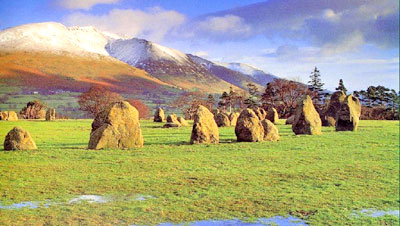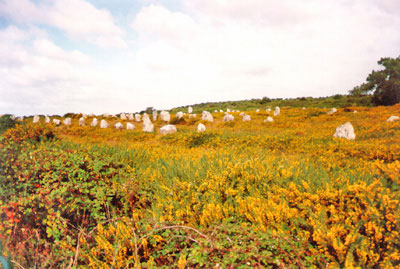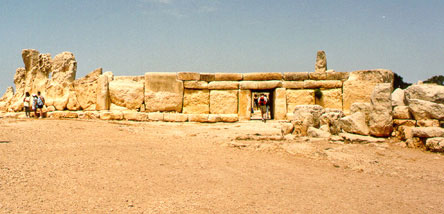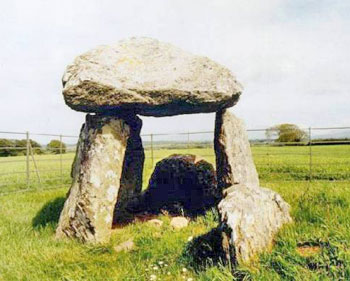|

by Philip Coppens
This article originally appeared in
Frontier 1.2 (1995) and has been
adapted
from
PhilipCoppens Website
|
The “megalithic
civilization” in Western Europe is still a
civilization that is ill-understood, if only because it
has suffered from decades of scientific neglect. At
present, some of the answers about the monuments they
left behind is becoming clearer, but questions remain as
to who this civilization was, and what became of them.
.
Philip
Coppens |

The megalithic civilization has only in
recent years become the subject of serious scientific investigation.
Previously, it seems that most archaeologists preferred the warmer
climates of Egypt and the Middle East to identify our forefather’s
past. After all, was that area not the cradle of civilization?
In retrospect, the answer suggests it is not, for once the
megalithic monuments were subjected to dating, some were found to be
much older than their counterparts in Egypt.
Some of the problem between megalithic Western Europe and the
civilizations of the Middle East is a question of prior interest. We
have the Bible, the pyramids and tales of the ancient Gods. Europe
only seems to have Stonehenge. Europe has stories of how the Romans
came and conquered the local population, leaving a less than
impressive accounts of what for a long time were believed to be the
megalith builders. It once again took well into the 20th century
before it was realized that the megalith builders were as far
removed from the Romans as we are… and the earliest megalithic
builders more than twice that amount of years, predating the
construction of the pyramids.
This picture also threw the entire debate of what came first on its
head. Civilization was thought to have spread from the Middle East.
But redating of the megalithic monuments indicated that it could
have been the other way around – even though no-one has ever
suggested this. There are various reasons for this. When in the
early 20th century it was suggested that the Egyptian civilization
was created by “white men”, this was seen as either evidence of the
foolish theory of Atlantis, or of racism on the part of the person
expressing that opinion. Though there is nothing to indicate that
“white men” did indeed create Egypt, the intriguing conclusion of
the available evidence is that they could have been. Furthermore,
“megalithic Europe” communicated with each other via the shores,
using boats.
Barry Cunliffe has labeled it “Facing
the Ocean”, as most of the people traveled along the Atlantic shores
of Western Europe, reaching from the Orkneys in the North, to
Morocco in the South. Thus, they had the boats to enter the
Mediterranean Sea and “seed” civilization there. Whether the
enigmatic megalithic
structures of Malta should therefore be seen as
an influence from the west or the east is a good question – and the
most likely answer might be that it was influenced from both sides,
resulting in the unique structures the megalithic temples of the
island have.
Despite making progress, little is still known about “the megalithic
civilization”. Megalithic literally means “large stones”, and thus
the civilization is identified by the legacy they left… and which in
Western Europe was often the subject of violent destructions in the
16th till 19th century, when terrain with megalithic remains were
often reclaimed for agricultural purposes.
The destruction or burial of stones, including those at Avebury,
makes the search for purpose and interpretation of the sites more
and more difficult.
Today, megaliths seem to have survived
more in desolate locations – unless they are of the magnitude of
Stonehenge and Avebury, which were outside of all proportions that
the largest stones remained intact. But finding megaliths on the
slopes of mountains in the Lake District and not in the centre of
London should not lead one to conclude that megaliths were built in
inaccessible locations; more that those in the centre of London were
probably raised to the ground by Roman if not earlier times.
Major inroads into the megalithic civilization were created by
Gerald Hawkins and Alexander Thom. Hawkins stated that Stonehenge
clearly displayed astronomical knowledge and hence concluded it was
a calendar. Archaeologists disagree with the calendar, but do agree
that the alignments of Stonehenge are there because the builders had
specific ritual festivities at the main events of the sun: the
equinoxes and the solstices.
 Thom concluded that many of the lesser
known monuments also had stellar alignments; and his research
occurred largely in Brittany, thus showing that the astronomical
component of the megalithic structures seemed at the core of the
building of the monuments itself. Since then, this possibility has
been confirmed in almost all megalithic remains, as far as Egypt.
Still, when their theories were originally aired, Thom and Hawkins
were largely treated as parias in the scientific community. Thom concluded that many of the lesser
known monuments also had stellar alignments; and his research
occurred largely in Brittany, thus showing that the astronomical
component of the megalithic structures seemed at the core of the
building of the monuments itself. Since then, this possibility has
been confirmed in almost all megalithic remains, as far as Egypt.
Still, when their theories were originally aired, Thom and Hawkins
were largely treated as parias in the scientific community.
Thom and Hawkins were breaking the
barrier that the megalithic civilization was indeed worthy of
scientific study. Furthermore, they began to push the boundaries,
making it older than Egypt and the rest of the Middle East. That did
not go down well, and it was even more bizarre that one researcher
who followed in their steps, Martin Brennan was not allowed to enter
Ireland after he had climbed a fence to photograph a sunrise from a
megalithic monument.
Much less known, yet equally impressive, is the 20 year long study
performed by Aubrey Burl, who finished his overview of hundreds if
not thousands of megalithic monuments in Europe in the mid 1990s.
His conclusion read that the first crude stone structures were
created in the Lake District, north-western England. From there,
they spread South, towards Wessex, Devon and Cornwall. From there,
they reached south-western Ireland. Northern Ireland was “seeded”
directly from the Lake District, as it was a short stretch of water
that separated the two locations. As to their purpose, Burl was very
careful, but did suggest that he felt they had a religious purpose,
though a dual purpose, such as meeting place for tribes or between
tribes, was most likely a secondary purpose of the sites.
An important clue is that even though Brittany is well-known for its
tremendous concentration of megalithic monuments, it is in the far
less known region east of Paris, around the city of Sens, that the
largest concentration can be found. As the area is largely urban and
industrial and not a holiday destination like Brittany, few people
are however aware of this fact. One person who did become intrigued
by these stones was the Belgian historian Marcel Mestdagh.
His area of expertise were the Viking
invasions. He noted that the invasion pattern in western Europe
seemed to follow a particular feature of the landscape that other
researchers had been unable to identify. Mestdagh believed that this
pattern had to do with the distribution of megaliths across the
landscape. Furthermore, he noted that this pattern seemed to focus
in on Sens, which was unique from a Viking perspective in the sense
that the town was besieged, rather than sacked as all other towns.
Aware that megaliths were often used by later people as border
stones, Mestdagh wondered whether they might actually be markers
along the roads.
Since then, other researchers have come
to the conclusion that many megalithic monuments were indeed
situated along ancient roads. If the megaliths marked roads – and
noting that the Vikings found a Europe that was largely rural, not
urbanized, could it be that they followed this system, eventually
ending up in Sens? If so, then it meant that all roads seemed to
lead to Sens – which made sense, as, having the largest
concentration of megaliths, it might thus be the capital.
Furthermore, Sens was close to Paris, which in later years would
become the capital of France.

Where did the megalithic builders come from, and more importantly,
where did they go to? Whereas the local European population at the
time might have decided to just start erecting large stone
monuments, the question is why they stopped – and whether they
abandoned the regions they formerly inhabited. And if so, why?
As they left no written sources, identifying these people by their
language is impossible. Thomas O’Rahilly researched early Irish
history and came across an ancient language that had words that were
Indo-European. One of these dialects was the Hiberno-Brittany
dialect, known as Ernbelre, the language of the Erainn. In
The
Secret Languages of Ireland, R.A. Stewart MacAlister noted how he
came across a group of people in Liverpool, a group largely on the
outskirts of society. They still spoke Ernbelre, in the beginning of
the 20th century. He concluded that the megalithic people were still
alive at the time of the Roman conquest. They were known as Ateconti
(Aithech Tuatha, “for rent”), as they were used in the Roman
legions. Later, the Irish would consider them to be lowest of all
social classes.
MacAlister noted that the group still lived as if they were a clan,
marrying inside the clan, behaving in mysterious ways about their
language, etc.
Though their descendents may thus have lived onwards in Western
Europe, what made them stop building with “large stones”? The
megalithic civilization in Europe ended in ca. 1200 BC, roughly the
time when Stonehenge was no longer extended. It times the end, but
does not identify the cause.

Perhaps foreign invaders came into Western Europe. Another option
might be that the end of the megalithic civilization coincided with
the onset of a Dark Age in Europe. It would last approx. half a
millennium, when the Greek and Roman civilizations began to
flourish. The onset of the Dark Age is also linked with the end of
the Cretan civilization, which itself was linked to the eruption of
the Santorini volcano.
Might the massive eruption of this volcano
have destroyed the Western economy? As both Crete and the Megalithic
civilization were strongly relying on the sea as a means of
communication, this may be the real cause for the end of the
megalithic era: the downturn in the European economy meant that
there was no more time or resource for a continued expansion of
megalithic monuments, such as Stonehenge.
However, the end of the civilization remains largely shrouded in
mystery – and might remain for a while longer.
|


 Thom concluded that many of the lesser
known monuments also had stellar alignments; and his research
occurred largely in Brittany, thus showing that the astronomical
component of the megalithic structures seemed at the core of the
building of the monuments itself. Since then, this possibility has
been confirmed in almost all megalithic remains, as far as Egypt.
Still, when their theories were originally aired, Thom and Hawkins
were largely treated as parias in the scientific community.
Thom concluded that many of the lesser
known monuments also had stellar alignments; and his research
occurred largely in Brittany, thus showing that the astronomical
component of the megalithic structures seemed at the core of the
building of the monuments itself. Since then, this possibility has
been confirmed in almost all megalithic remains, as far as Egypt.
Still, when their theories were originally aired, Thom and Hawkins
were largely treated as parias in the scientific community. 
